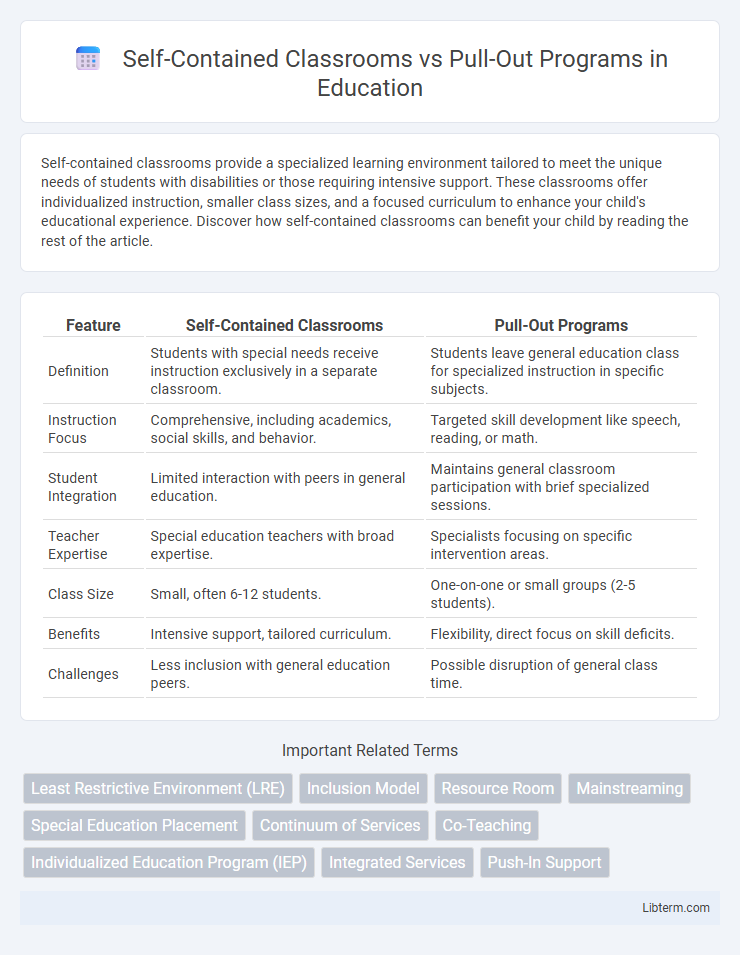Self-contained classrooms provide a specialized learning environment tailored to meet the unique needs of students with disabilities or those requiring intensive support. These classrooms offer individualized instruction, smaller class sizes, and a focused curriculum to enhance your child's educational experience. Discover how self-contained classrooms can benefit your child by reading the rest of the article.
Table of Comparison
| Feature | Self-Contained Classrooms | Pull-Out Programs |
|---|---|---|
| Definition | Students with special needs receive instruction exclusively in a separate classroom. | Students leave general education class for specialized instruction in specific subjects. |
| Instruction Focus | Comprehensive, including academics, social skills, and behavior. | Targeted skill development like speech, reading, or math. |
| Student Integration | Limited interaction with peers in general education. | Maintains general classroom participation with brief specialized sessions. |
| Teacher Expertise | Special education teachers with broad expertise. | Specialists focusing on specific intervention areas. |
| Class Size | Small, often 6-12 students. | One-on-one or small groups (2-5 students). |
| Benefits | Intensive support, tailored curriculum. | Flexibility, direct focus on skill deficits. |
| Challenges | Less inclusion with general education peers. | Possible disruption of general class time. |
Understanding Self-Contained Classrooms
Self-contained classrooms serve students with significant learning disabilities by providing specialized instruction within a dedicated classroom environment, often led by teachers with expertise in special education. These classrooms enable individualized learning plans and concentrated support, promoting skill development tailored to each student's unique needs. This approach contrasts with pull-out programs, where students temporarily leave general education classes for targeted assistance, emphasizing the comprehensive, continuous support available in self-contained settings.
What Are Pull-Out Programs?
Pull-out programs are specialized instructional settings where students are temporarily removed from the general education classroom to receive focused support in areas such as speech therapy, reading intervention, or special education services. These sessions are typically shorter and more targeted, designed to address specific learning needs while allowing students to remain integrated with their peers for most of the day. Pull-out programs provide individualized attention without isolating students for extended periods, promoting skill development within a flexible framework.
Key Differences Between Both Approaches
Self-contained classrooms provide specialized instruction within a dedicated environment where students with similar learning needs remain throughout the school day, fostering consistency and tailored support. Pull-out programs involve temporarily removing students from general education settings for focused instruction, allowing integration with peers during other times. The key difference lies in the intensity and duration of specialized support, affecting social interaction and curriculum delivery.
Benefits of Self-Contained Classrooms
Self-contained classrooms provide a structured and consistent learning environment tailored to students with special needs, promoting individualized instruction and fostering strong peer relationships within the same group. These classrooms enable teachers to closely monitor progress and adjust teaching strategies promptly, enhancing academic and social development. The focused setting reduces distractions and supports students in building confidence and independence through targeted support.
Advantages of Pull-Out Programs
Pull-out programs offer tailored instruction by allowing students to receive specialized support in smaller groups, enhancing individualized learning and addressing specific academic needs. These programs enable collaboration with general education teachers, facilitating targeted interventions without removing students from the core classroom environment entirely. Pull-out settings also promote skill development in critical areas such as reading, math, or speech therapy while maintaining connections with mainstream peers.
Challenges in Self-Contained Classrooms
Self-contained classrooms often face challenges such as limited peer interaction and reduced exposure to diverse learning environments, which can impact social skill development. Teachers in these settings may encounter difficulties in addressing a wide range of individual needs within a single classroom due to varied levels of ability and behavioral issues. Resource constraints and insufficient specialized training can further hinder effective instruction and student progress in self-contained classrooms.
Common Issues with Pull-Out Programs
Pull-out programs often face challenges such as disrupted learning continuity and social isolation from peers, which can negatively impact student engagement and academic progress. These programs may also create scheduling conflicts, leading to lost instructional time in the general education classroom. Additionally, inconsistent communication between pull-out instructors and classroom teachers can hinder coordinated support for students with special needs.
Student Outcomes: Comparing Both Models
Self-contained classrooms provide continuous, immersive support with tailored instruction, fostering stronger social skills and academic growth for students with special needs. Pull-out programs offer targeted interventions in specific subjects, allowing access to general education while addressing particular learning gaps. Research indicates that self-contained classrooms often yield better long-term academic outcomes, whereas pull-out programs enhance subject-specific performance and integration into mainstream settings.
Deciding Factors for Parents and Educators
Deciding factors for parents and educators between self-contained classrooms and pull-out programs revolve around individualized learning needs and social integration. Self-contained classrooms offer consistent support within a specialized environment, benefiting students requiring intensive assistance, while pull-out programs provide targeted instruction without removing students entirely from general education settings. Considerations include the student's academic goals, social development, and the availability of resources to ensure the chosen option aligns with long-term educational success.
Future Trends in Special Education Placement
Future trends in special education placement emphasize a shift toward inclusive models, integrating self-contained classrooms with pull-out programs to tailor individualized support for diverse learner needs. Advancements in technology and data-driven instruction enhance both settings, enabling real-time progress monitoring and personalized interventions. Collaboration between general and special educators is increasing, promoting seamless transitions and fostering greater academic and social outcomes for students with disabilities.
Self-Contained Classrooms Infographic

 libterm.com
libterm.com